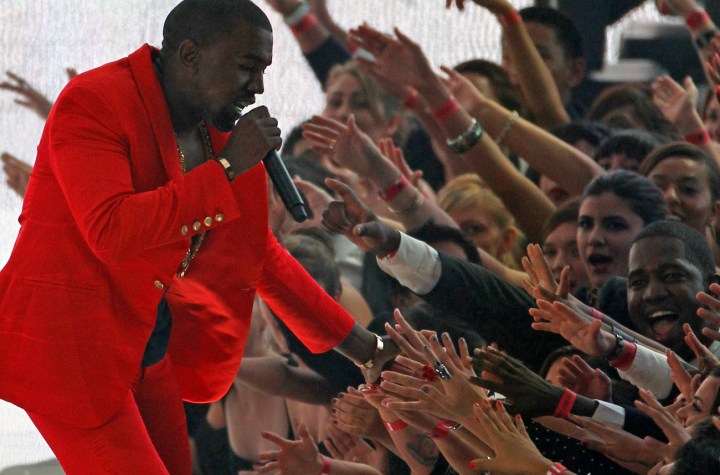Media
Rap, the gangsta’s paradise art, receives its due

2010 saw the release of the highly touted The Anthology of Rap from Yale University Press, hip-hop luminary Jay-Z’s songbook/memoir Decoded, and Kanye West’s magnum opus My Beautiful Dark Twisted Fantasy. Taken together, these three milestones demand a critical reconsideration of a controversial art form. BY RICHARD POPLAK.
The tricked up Honda rolls by in hip-hop video slow-mo. Spinning rims kick up shards of sunlight; the car rattles with thumps of bass, each soundwave as thick as a roiling boa. A tinted window lowers. Behind the cigarette smoke, four Arab shebabs wear black shades, chains, attitude. Their faces are scarred, their hair gooped with gel. It is 11am in the birthplace of Saint George, patron saint of Palestine, not 50 kilometres from Bethlehem. But you will never see this place featured in “Follow the Footsteps of Christ” brochures.
Under the shadow of hulking factories, the mixed Israeli city of Lod – population 67,000 – looks like an empty set for a Run DMC video, a desert re-imagining of an old-skool ‘hood. Busted tenements swoon against broken community centres, spilling into the embrace of barbed-wire barricades. It’s a place that evokes the Bronx, mid-1970s, from which rap was born – the cataclysmic low point of American inner-city blight. The first hip-hop generation was raised on streets like these. Their music crossed the borders between boroughs: into Brooklyn, into Queens, into Manhattan, beyond.
Lod feels like hip-hop’s last stand. It is one of the Middle East’s most violent, crime-riddled burgs, gutted in 1948 during the Israeli War of Independence (or the naqba – the Disaster – depending on your point of view), when the bulk of Lod’s Arab citizens were expelled from the city in a ragtag huddle. This broken place is a metaphor for the local condition: severed by concrete, sutured by riot cops, it speaks to the divide. Lod is also ground zero of the Israeli-Arab hip-hop scene, home to Palestinian rap’s biggest deal: Tamer Nafar and his DAM crew, infamous for their oft-downloaded 2001 hit You’re the Terrorist.
Watch DAM: Meen Erhabe? (Who’s the Terrorist?)
DAM, like so many hip hoppers the world over, claim ownership. “Rap is an Arab art form,” Tamer tells me. “It belongs to us, not just to Americans.” This echoes the words of South African Kwaito star Zola, who insisted in an interview that even though he had heard Run DMC growing up in Soweto, “there is no American rap in my music, man. We had no money – we couldn’t afford that stuff.” Both artists have a point – one finds the rhythm of Qu’ranic recitation in rap’s DNA, because early Bronx MCs mimicked Nation of Islam preachers to get their flow down. And, of course, rap is only a few parts removed from thousands of years of African oral storytelling – the form is a direct descendent of Signifying and the Dozens, glorious African-American oral traditions that smack redolently of the Mother continent.
But make no mistake, rap is a black American art form gone hysterically global. To say otherwise is to deny what makes it compelling in the first place – it is confrontational protest music that spits in the face of authority, even as it commodifies black death and pitches sneakers, champagne and baggy jeans. It’s a mess of contradictions – misogynist, violent, homophobic, racist. poetic, tragic, artful, transcendent. It is, at best, a warhead delivering pointed rage through the ancient mediums of music and language. It’s the sound of the oft-punched punching back.
“Form in poetry silences the conceptual meaning of words; it is therefore the condition of the direct gaze upon the world,” wrote Yves Bonnefoy. Judged by this impeccable criterion, rap is undoubtedly a poetic form. That’s certainly the position of Canadian academic Andrew DuBois and African-American literature scholar Andre Bradley, who make exactly that case in their Anthology of Rap (Yale University Press.) That publication, along with the consensus pick for album of the year, Kanye West’s My Beautiful Dark Twisted Fantasy, and Jay-Z’s just released sort-of-memoir Decoded, form a compelling body of evidence arguing for rap’s induction into the pantheon.
According to Bradley and DuBois, “[The Anthology of Rap] treats rap as a body of lyrics that responds to transcription, explication and analysis as poetry.” They call rap a “laboratory of language for those interested in the principles of poetics.” For long-time rap fans like myself, this is nothing new. For the neophyte, it may come as something of a revelation. The editors have selected 300 songs, organised into four sections: 1978-1984 – The Old School; 1985-1992 – The Golden Age; 1993-1999 – Rap Goes Mainstream; 2000-2010 – New Millennium Rap. Chronology is always a safe way to anthologise, but The Anthology of Rap shouldn’t be mistaken for a history of the form (for that, Jeff Chang’s Can’t Stop, Won’t Stop is still the definitive volume, even if Henry Gate’s Jr’s opening essay does offer some swift cultural contextualisation.)
One can argue for or against the song choices, but for the most part, Bradley and DuBois (along with their who’s-who team of advisors) have steered clear of controversy. An anthology is always subject to taste, and the editors – occasionally squeamish— step gingerly around Li’l Wayne’s wacked-out scatology, or Dr. Doom’s weirdo bestiality – indelible parts of rap’s dark Id. The exclusions, however, are nowhere near as egregious as the decision not to annotate. For those of us reared on rap, black American street English has become part of our lexicon. But if Bradley and DuBois are serious about making a case for rap as a genuine poetic form, they need to give the uninitiated (and readers 50 years hence) the tools to navigate the rhymes, which can at times be as arcane as Chaucer. Take the following from Snoop Dogg, featuring Dr. Dre, on Nothing but a G Thang:
Gimme the microphone first so I can bust it like a bubble
Compton and Long Beach together, now you know you’re in trouble
Ain’t nuttin but a G thang, baby!
Two loc’ed out niggas, so we’re crazy!
Death Row is the label that pays me!
Unfadeable, so please don’t try to fade this (Hell yeah!)
Each artist earns an introduction that places him or her in a historical and geographical continuum, but it would, for instance, be helpful to know more about Compton and Long Beach’s relationship (rap is minutely regional, as battle poetry should be), and that “loc’ed out” is derived from the Spanish loco, or crazy – a particularly Los Angeles flourish that is central to Snoop’s laid-back West Coast appeal. Dead obvious to Snoop’s fans; inscrutable to someone new to the form.
Watch Dr. Dre, Snoop Dogg – Nuthin’ But A G Thang:
Jay-Z makes no such omission in Decoded; here, the pleasure is in the discursive annotations. The book winds through the discography of the one artist even people who hate rap tend to cite as a genius. Given Jay-Z’s status, Decoded is almost unnecessarily literate – fans would gobble up the minutia if he’d written them in barely legible shorthand. But that’s not the Hova’s style.
Jay-Z pulls off the nearly impossible: he helps the reader consider the musicality of the lyrics, which is essential to understanding how his songs are constructed. Lyrics are only one ingredient in rap’s recipe book – there is also the produced music, and the way the rapper delivers those lyrics over the beat. “Beat is only one half of a rap song’s rhythm. The other is flow,” writes Jay-Z. “When a rapper jumps on a beat, he adds his own rhythm. Sometimes you stay in the pocket of the beat and just let the rhymes land on the square so that the beat and flow become one. But sometimes the flow chops up the beat, breaks the beat into smaller units, forces in multiple syllables and repeated sounds and internal rhymes, or hangs a drunken leg over the last bap and keeps going, sneaks out of that bitch. The flow isn’t like time, it’s like life. If beat is time, flow is what we do with that time, how we live through it.”
Indeed, what raises Jay-Z’s music to the level of art – the very thing that has allowed him to produce three perfect American albums and a host of other near classics – is not so much his lyrical content (superb as it often is), but the way he snakes around the beat with his delivery. Metre is malleable in Jay-Z’s hands, something he uses to defy expectations, to keep his music consistently surprising. He makes a fool of the laws of physics, which is another way of saying that he’s a magician.
Watch the song that replaced Frank Sinatra’s New York, New York as the NY official song, Empire State of Mind:
Jay-Z’s Decoded doesn’t need to be a memoir – his work has mined his life, and he’s wrenched more poignancy from his teenage years as a crack dealer in Brooklyn than seems possible. Yet to Jay, the young hustler figure – a persona he helped turn into a universal cultural icon – is what elevated rap from novelty party songs or strident protest music into a uniquely American art form. His work is documentary evidence of both the decline of the American dream, and the durability of American optimism.
Which brings us to Kanye West’s My Beautiful Dark Twisted Fantasy, the album destined to become shorthand for the tumult of the Obama years. Boastful, excessive, profane, overlong, overblown, operatic and thoroughly mind-blowing, West’s opus is in many respects the rap record that, if the planet exploded now, would neatly encapsulate the four sections of The Anthology of Rap into one blistering record. Heavy on the guests, massively produced – the work of an ego so prodigious that it often implodes, like a dying supernova – West has made a case for himself as the form’s summarising force. “No one man,” raps West, “should have all that power.” And yet, there it is.
Rap is a global force, a keystone of the music industry, and established genre. Still, it remains misunderstood and underappreciated by those who dismiss it for its worst traits. But, as West puts it, “screams from the haters got a nice ring to it.” We’ll leave it to Jay-Z to explain why Arab kids from Lod, and a young pantsula from Zola, Soweto, found in rap something they could make their own: “[The] hustler’s story – through hip-hop – has connected with a global audience. The deeper we get to those sidewalk cracks and into the mind of the young hustler trying to find his fortune there, the closer we get to the ultimate human story, the story of struggle, which is what defines us all.” DM
Main photo: Kanye West reaches into the crowd as he performs at the 2010 MTV Video Music Awards in Los Angeles, California, September 12, 2010. REUTERS/Mike Blake















 Become an Insider
Become an Insider